-
Male 35yo Jan 2015
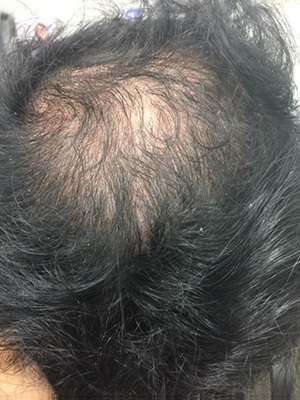
Before -
Male 35yo April 2016
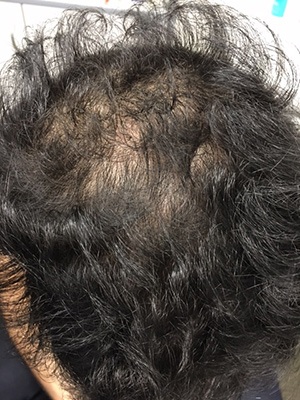
After
Why am I losing hair?
Approximately 90% of hair on the scalp is in a growing phase (anagen). This is followed by 2 phases (catagen and telogen) where the follicles are smaller and then rest. Resting hairs fall out after a period of 3-4 months and new hairs grow. It is normal to lose some hair as a part of normal hair cycle, but when hair loss is severe it is considered a disorder.
What are the causes of hairloss?
Hair loss or alopecia can occur for a number of reasons and the most common cause is Androgenic alopecia. This can occur both in males and females. This is a condition which is potentially treatable and reversible if patients present early.
Androgenic alopecia - is also known as male-pattern or female-pattern baldness. The growth phase of the hair is shorter which results in increased shedding and miniaturisation of the follicles occur i.e. with each hair cycle the hairs appear smaller and finer. This condition is reversible in the early stages with lotions and some patients may require tablets to stop or slow the progress.
Other causes of hair loss include
- Telogen effluvium: This may be a result of shock, chronic illness or major surgery
- Traction alopecia: This commonly occurs when hair is tied or pulled tightly into ponytails or braids causing stress on the hair follicles and eventually hair loss which can be permanent.
- Cicatricial alopecia: Also referred to as scarring alopecia. This is seen in conditions such as lichen planus and discoid lupus. The process destroys the hair follicles. Fortunately both diseases can be treated and hair loss can be minimised.
- Hormonal imbalances: Imbalance in male and female hormone levels and thyroid gland can cause hair loss.
- Medicines such as anticoagulants, birth control pills and antidepressants
- Fungal and bacterial infections of the scalp
- Poor nutrition
- Underlying Disease: Hair loss appears as an early symptom of some conditions
How to treat hair loss?
The treatment of hair loss depends on the cause. At your appointment with our experienced dermatologist, a full history will be taken and the hair and scalp will be examined. Sometimes blood tests and a biopsy of the scalp maybe necessary to assist with diagnosis. At your follow up appointment, the results of the tests and treatment options will be discussed. The sooner treatment is started, the better the results.
Male 35yo Jan 2015 and the second photo :April 2016
Maximum regrowth occurs after 2 years of treatment and depends on many factors including genetics and nutrition.
Hair Loss Before and After
-
Hair Loss Before and After
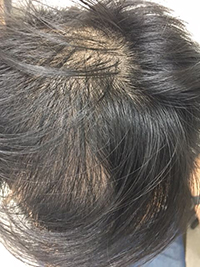
March 2017 -
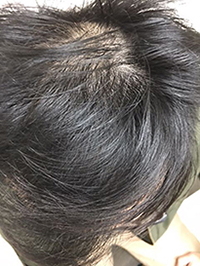
August 2017 -
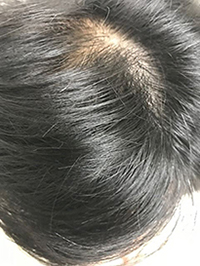
March 2018
Scalp Disorders
Disorders of the scalp affect many people, and are often a source of embarrassment and discomfort for the affected individuals. Scalp problems can result in hair fall and rash like symptoms on the scalp. The density of hair and high levels of oil secretion on the scalp skin makes it more susceptible to infections and inflammatory problems. Some of the disorders can be passed on from one person to another through contact.
Types
Some of the common scalp disorders include:
- Dandruff: flaky skin
- Cradle cap: greasy, yellowish crusts or scales most often seen in infants
- Head lice
- Ringworm: fungal infection
- Folliculitis: bacterial infection that affects the hair follicles
- Psoriasis: inflammatory skin condition
Symptoms
The symptoms of scalp disorders vary from one disorder to another. They may include noticeable damage to the hair in the form of hair breakage, hair loss, and thinning of hair. The scalp might also appear flaky, crusty or itchy.
Causes
Scalp disorders may be caused by inflammation, infections (bacterial, viral, parasites or fungal), other associated skin conditions like psoriasis, or as a response to an allergy. Individuals suffering from certain autoimmune diseases may experience scalp problems that may not be significant in the beginning, but may become serious with the progression of the disease. Certain disturbances in hormone levels in the body, genetics and nutritional deficiencies can also cause hair loss.
Diagnosis
Your doctor will conduct a thorough examination of your head. Diagnosis may be confirmed by taking scrapings from the infected region and viewing under a microscope or taking a biopsy or sample of scalp and hair.
Treatment
Hair loss is most often managed by treating its underlying cause, Some scalp disorders can be treated by frequent shampooing with a medicated shampoo. Sometimes, your doctor may prescribe antibiotic or antifungal medications to treat infections.
Prevention
Scalp problems can be avoided by taking proper care of your scalp and hair with regular washing and shampooing. Your hair reflects what you eat, so ensure that your diet contains adequate proteins. You may include protein rich foods such as fish, eggs, grains, and nuts in your diet for a healthy scalp.
